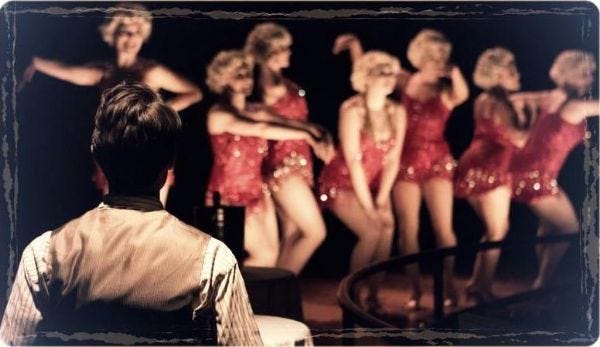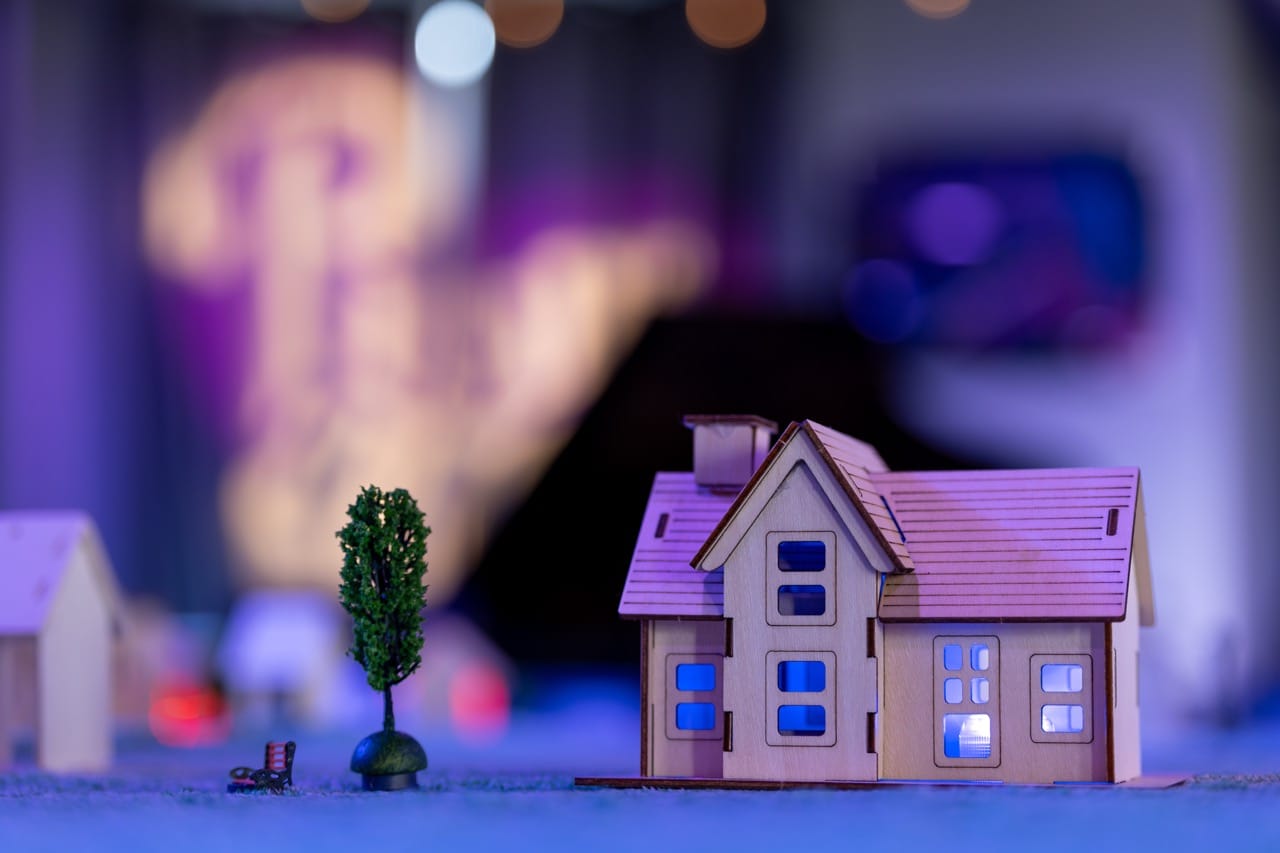
There I was, back in North Beach, the scene of so much trouble in my misspent youth. I’d fallen in love here, once, and I played at love here too. Broken hearts, all around.
I’d sworn the streets of San Francisco off, but they dragged me back for one last job. One last night of back alleys and misdirection. Of shadows with familiar faces. I’d come here to case Sal’s joint, one step ahead of the Feds — as usual.
Sal’s joint, Doc’s Clock, The Palace Theatre, these are some of the many names given to the set pieces of Boxcar Theatre’s The Speakeasy — a labyrinthine immersive production that has taken up residence under the streets of San Francisco’s North Beach.
That’s not an exaggeration, either: the damn show is quite literally underground. Although the journey starts before then, with a “clandestine” meeting on the streets of North Beach where you are handed instructions to one of three separate entrance points to the venue, each with its own false front entrance.
In terms of sheer scale and production value there is little as audacious as The Speakeasy on the West Coast. An entire dinner theatre space was carved out to serve as just one of the platforms on which a criss-crossing web of stories takes place. Your ticket determines your starting point, and what thread of the story tapestry you begin with. After the first act the doors to the rest of the venue open up and The Speakeasy becomes a sandbox in which the audience can play. In the case of the casino room, quite literally, in the form of fake-gambling.
The most striking thing about The Speakeasy is the sheer attention to detail. The venue itself is an aggressively designed space that successfully creates the sense that you’ve found a back door to Prohibition-era San Francisco. That a good chunk of the audience does its best to play along with the visual motif of flappers and dandies helps the illusion along. There’s a naturalism to much of the design work, with a few conceits thrown in here and there to fulfill the voyeuristic requirements of the show’s narrative.
More than once during the show I stepped back and couldn’t really believe that the production team had pulled this off. While not at the scale of Sleep No More’s McKittrick Hotel, the tightly wound trio of Palace Theatre, casino, and speakeasy have the weight of a virtual reality quite different from the dreamlike space of Punchdrunk’s work.
Unlike the seminal SNM, however, The Speakeasy is a linear narrative experience. The conceit is that the audience are guests of this forbidden resort under the streets of the City, run by the mobbed up “Sal” and featuring an assortment of show girls, vaudevillians, drunks, neer-do-wells, toughs… you name it. The full gambit of 1920’s era archetypes are here, along with a couple of kids thrown in for verisimilitude’s sake.
Get Noah J Nelson’s stories in your inbox
Join Medium for free to get updates from this writer.
SubscribeSubscribe
For the entire length of the program a fully functioning vaudeville show ran in the Palace Theatre room, pausing only — from what I saw — to move the personal storylines of a few characters forward either through “chance” encounters or dream-like reveries. The later trope was seeded (again from my perspective, with a track that began in the charming speakeasy set) in the first act, as individual highlighted scenes alternated with action that played out in the whole room: the audience being trained to accept an occasional theatrical digression from naturalism.
All while the actual bar cranks out a fairly steady supply for the patrons.
That would sometimes cause a problem over the course of the night, as those who were good and sauced up forgot the number one rule of a speakeasy: speak easy. The worst case of this was in the “secret” room that allowed a good gaggle of patrons to watch the action in the ladies dressing room through a one way mirror. Here the showgirls revealed their secrets and experienced their own reveries which shed light on the tangled webs that held the characters together. From what I could tell it was the most narratively important space in the whole venue, the one place you could reliably return to in order to find out what was really going on.
Which made the lounging about of a cadre of friends, tipsy and eager to supply the DVD commentary for the action all the more annoying. That this happened more than once as I returned to the room after pursuing a character “off-stage” suggested to me that it might have been wise to station an usher inside the room at all times. Pricey as that prospect would be.
In spite of solid world-building — both physical and in terms of the intricate interrelationships of the characters — a few things stood in the way of me falling in love with the show as much as I fell in love with the space.
The first is the linearity of the narrative, which normally wouldn’t be an issue if it wasn’t for the density of the soap opera that makes is The Speakeasy. Because the action is naturalistic — most of the time — and the story moves relentlessly forward, large chunks of context are lost in any given scene. This can sometimes be less of an issue with regard to the enjoyment of any one particular scene, but the larger sweep of a given plot can be hard to follow. Sandbox structures and linear narratives are, to a fair degree, antagonistic towards each other. It’s a puzzle with a high degree of difficulty, and they don’t quite stick the landing.
As a fan of deeply immersive work I found the imaginary veil that separated the audience from the characters — literalized in the form of the one-way mirror — to be a frustration. That’s not an entirely fair criticism to haul out, as tearing down the veil doesn’t seem to be the show’s intention, but I need to cop to how it affected my mood. While the aim of The Speakeasy was to immerse us in the world of the show, there seemed to be only so much going on to bring patrons into the same emotional plane as the characters. This wasn’t uniform, as there were people who were drawn into Sal’s office and other locations, but from the outside these seemed to be incidental from the mechanics of the plotting.
For the most part, though, it seemed like the smartest way to tackle the show wasn’t to quest after a given character — as myself and a few others patrons who seemed to have the immersive bug did — but to sit your keister down somewhere and absorb what was going on in the room. For those who haven’t been to a lot of immersive theatre it would likely make for an easy introduction of the form. When I did that, the charm rebuilt itself and I found myself back in the swing of things.
The biggest thing that kept me from being gaga over the whole experience was the length. If anything The Speakeasy errs on the side of trying to give us too much bang for your buck. Part of this comes from my companion for the evening losing steam in the last half-hour of the show, but even I — who do these things all the time — found myself wanting the production to leave me wanting more. A tighter loop, with a few story threads pulled out, might also make for a more compelling narrative. At a certain point there felt like there were more storylines than space to contain them.
Which leads me back to what’s well worth praising about The Speakeasy: they’ve built a wondrous theatrical machine here. A darkly sparkling venue that runs a seamless tab system — it is brilliant in its simplicity — with a cast who hits all the period notes with the aplomb of theatre veterans. There’s no reason why The Speakeasy shouldn’t stand in San Francisco for years to come, giving tourists a thrill and iterating on their narrative formula until it gleams as brightly as the lights of the Palace Theatre stage.
The Speakeasy currently plays Friday and Saturday nights through July 1st. Tickets are $55-$130 dollars















Discussion